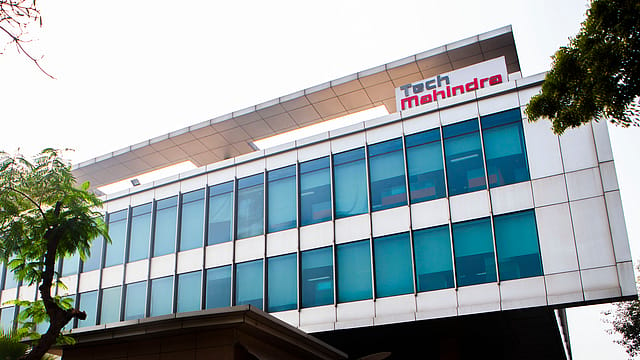Tech Mahindra shares fall 6% post Q3; what should investors do?
ADVERTISEMENT

Shares of Tech Mahindra plummeted 6% in early trade on Thursday, in sync with the broader market as well as weakness in the IT space, as investors reacted negatively to its December quarter earnings. The IT heavyweight was the top loser on the BSE, followed by private lenders Axis Bank and HDFC Bank, HCL Technologies, and ITC, which fell in range of 1-2%. On the other hand, the BSE benchmark Sensex dropped 0.8% to 70,515 mark, while the BSE IT index was down over 1%.
Tech Mahindra shares opened lower at ₹1,349.65, down 4.1% against the previous closing price of ₹1,407.75 on the BSE. In the first hour of trade so far, the IT major declined as much as 6% to ₹1,322, while the market capitalisation dipped to ₹1.3 lakh crore.
At the current level, shares of Tech Mahindra trade nearly 7% lower than its 52-week high of ₹1,416 touched on January 23, 2024. The stock has risen 34% against its 52-week low of ₹982.95 hit on April 28, 2023. In the last one year, the counter has gained 27%, while it rose 15.5% in six months and 4% in a month.
In the October-December period of FY24, the software services firm saw a 60.6% year-on-year (YoY) fall in its net profit to ₹510 crore, weighed down by muted demand in banking, financial services and insurance (BFSI), communications and hi-tech segments.
The consolidated revenue from operations slipped 5% YoY to ₹13,101 crore in Q3 FY24, compared with ₹13,734 in the year-ago period. Segment-wise, the communications and media vertical, the largest revenue generator for Tech Mahindra, saw a 13.4% year-on-year decline in revenue. BFSI posted a 7.8% drop in revenue, while the manufacturing vertical’s revenue rose 8.7% in Q3 FY24.
January 2026
Netflix, which has been in India for a decade, has successfully struck a balance between high-class premium content and pricing that attracts a range of customers. Find out how the U.S. streaming giant evolved in India, plus an exclusive interview with CEO Ted Sarandos. Also read about the Best Investments for 2026, and how rising growth and easing inflation will come in handy for finance minister Nirmala Sitharaman as she prepares Budget 2026.
During the quarter under review, the software major signed new deals worth $381 million in the third quarter, much lower than $640 million in the previous quarter, and $795 million in Q3 FY23.
"The quarter was a mixed outcome, with growth in the Manufacturing and Healthcare segments but muted spending in areas like Communications, BFSI, and Hi-tech. While this dichotomy in the markets will take its own time to settle, we are focusing internally on realigning under the new structure and strengthening the foundations of our organisation,” says Mohit Joshi, managing director and chief executive officer, Tech Mahindra.
What should investors do post Q3?
What should investors do post Q3?
Foreign brokerage Morgan Stanley assigned an 'underweight' rating on Tech Mahindra with an upgraded target price of ₹1,220 per share from ₹1,100, citing that the company has good potential for turnaround. "We see the company as a good potential turnaround story candidate over the medium term. However, expect sharp downward revisions to consensus estimate in the near-term," the brokerage says.
HSBC has given a 'hold' call on the IT major, with a price target of ₹1,300 per share, while Nuvama Wealth Management has retained a 'reduce' call on the stock and lowered the target price to ₹1,020 from ₹1,050 earlier.
"Tech Mahindra’s weak bookings dwarf the bottoming out of its revenue decline and the potential uptick in margins in the near future. Investors eagerly await the new CEO's future strategy, to be unveiled in April 2024. We are cutting FY24E, FY25E and FY26E EPS (earnings per share) by 8.5%, 6.9%, and 1.4%, respectively, on lower growth and margins," Nuvama says in its report.
Analyst at Motilal Oswal Financial Services has maintained its ‘neutral’ view on the stock with a target price of ₹1,360. "Near-term growth remains weak and we await greater comfort on margins. We value the stock at 20 times FY26E EPS. We maintain our neutral rating on the stock," the brokerage firm says.
Axis Securities has given a 'Sell' call for Tech Mahindra, with a target price of ₹1,265 per share, implying a downside of 10% from the current market price. “From a long-term perspective, we believe Tech Mahindra is sorting out the client specific engagement issues on the verticals front and the deal pipeline remains sturdy. However, rising concerns over the prospects of large economies along with prevailing supply-side constraints pose uncertainties over the company’s short term growth rates.”
(DISCLAIMER: The views and opinions expressed by investment experts on fortuneindia.com are either their own or of their organisations, but not necessarily that of fortuneindia.com and its editorial team. Readers are advised to consult certified experts before taking investment decisions.)
